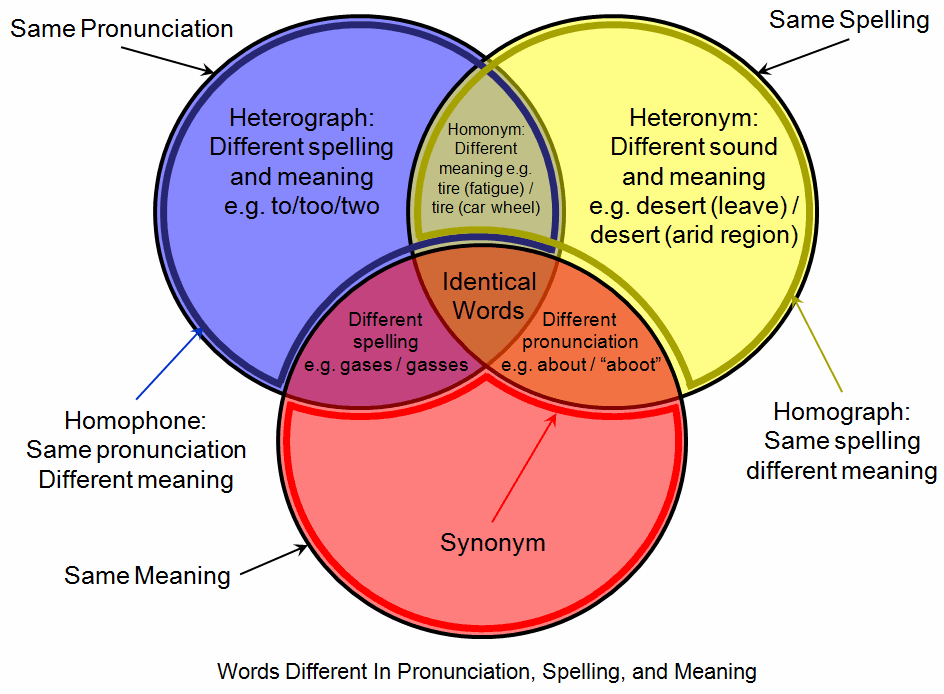|
Homonymy
In linguistics, homonyms are words which are either; ''homographs''—words that mean different things, but have the same spelling (regardless of pronunciation), or ''homophones''—words that mean different things, but have the same pronunciation (regardless of spelling). Using this definition, the words ''row'' (propel with oars), ''row'' (a linear arrangement) and ''row'' (an argument) are homonyms because they are homographs (though only the first two are homophones); so are the words ''see'' (vision) and ''sea'' (body of water), because they are homophones (though not homographs). A more restrictive and technical definition requires that homonyms be simultaneously homographs ''and'' homophoneshomonym ''Random House Unabridged Dictionary'' at dictionary.com—that is, they have identical spelling ''and'' pronunciation but different meani ... [...More Info...] [...Related Items...] OR: [Wikipedia] [Google] [Baidu] |
Homograph Homophone Venn Diagram
A homograph (from the , and , ) is a word that shares the same written form as another word but has a different meaning. However, some dictionaries insist that the words must also be pronounced differently, while the Oxford English Dictionary says that the words should also be of "different origin". In this vein, ''The Oxford Guide to Practical Lexicography'' lists various types of homographs, including those in which the words are discriminated by being in a different ''word class'', such as ''hit'', the verb ''to strike'', and ''hit'', the noun ''a strike''. If, when spoken, the meanings may be distinguished by different pronunciations, the words are also heteronym (linguistics), heteronyms. Words with the same writing ''and'' pronunciation (i.e. are both homographs and homophones) are considered homonyms. However, in a broader sense the term "homonym" may be applied to words with the same writing ''or'' pronunciation. Homograph disambiguation is critically important in spe ... [...More Info...] [...Related Items...] OR: [Wikipedia] [Google] [Baidu] |
Capitonym
A capitonym is a word that changes its meaning (and sometimes pronunciation) when it is capitalized; the capitalization usually applies due to one form being a proper noun or eponym. It is a portmanteau of the word ''capital'' with the suffix ''-onym''. A capitonym is a form of homograph and – when the two forms are pronounced differently – is also a form of heteronym. In situations where both words should be capitalized (such as the beginning of a sentence), there will be nothing to distinguish between them except the context in which they are used. Although some pairs, such as ''march'' and ''March'', are completely unrelated, in other cases, such as ''august'' and ''catholic'', the capitalized form is a name that is etymologically related to the uncapitalized form. For example, ''August'' derives from the name of Imperator Augustus, who named himself after the word ''augustus'', whence English ''august'' came. Likewise, both ''Catholic'' and ''catholic'' derive from a Greek ... [...More Info...] [...Related Items...] OR: [Wikipedia] [Google] [Baidu] |
Heterograph
A homophone () is a word that is pronounced the same as another word but differs in meaning or in spelling. The two words may be spelled the same, for example ''rose'' (flower) and ''rose'' (past tense of "rise"), or spelled differently, as in ''rain'', ''reign'', and ''rein''. The term ''homophone'' sometimes applies to units longer or shorter than words, for example a phrase, letter, or groups of letters which are pronounced the same as a counterpart. Any unit with this property is said to be ''homophonous'' (). Homophones that are spelled the same are both homographs and homonyms. For example, the word ''read'', in "He is well ''read''" and in "Yesterday, I ''read'' that book". Homophones that are spelled differently are also called heterographs, e.g. ''to'', ''too'', and ''two''. Wordplay and games Homophones are often used to create puns and to deceive the reader (as in crossword puzzles) or to suggest multiple meanings. The last usage is common in poetry and creati ... [...More Info...] [...Related Items...] OR: [Wikipedia] [Google] [Baidu] |
Heteronym (linguistics)
A heteronym (also known as a heterophone) is a word that has a different pronunciation and meaning from another word but the same spelling. These are homographs that are not homophones. Thus, ''lead'' ( /ˈlɛd/ the metal) and ''lead'' ( /ˈliːd/ a leash) are heteronyms, but '' mean'' ( /ˈmin/ average) and '' mean'' ( /ˈmin/ intend) are not, since they are pronounced the same. Heteronym pronunciation may vary in vowel realisation, in stress pattern, or in other ways. Description A heteronym is a homograph that is not a homophone, a word that has a different pronunciation and meaning from another word with the same spelling. Heteronym pronunciation may vary in vowel realisation, in stress pattern, or in other ways. "Heterophone" literally just means "different sound", and this term is sometimes applied to words that are just pronounced differently, irrespective of their spelling. Such a definition would include virtually every pair of words in the language, so "hetero ... [...More Info...] [...Related Items...] OR: [Wikipedia] [Google] [Baidu] |
Homophone
A homophone () is a word that is pronounced the same as another word but differs in meaning or in spelling. The two words may be spelled the same, for example ''rose'' (flower) and ''rose'' (past tense of "rise"), or spelled differently, as in ''rain'', ''reign'', and ''rein''. The term ''homophone'' sometimes applies to units longer or shorter than words, for example a phrase, letter, or groups of letters which are pronounced the same as a counterpart. Any unit with this property is said to be ''homophonous'' (). Homophones that are spelled the same are both homographs and homonyms. For example, the word ''read'', in "He is well ''read''" and in "Yesterday, I ''read'' that book". Homophones that are spelled differently are also called heterographs, e.g. ''to'', ''too'', and ''two''. Wordplay and games Homophones are often used to create puns and to deceive the reader (as in crossword puzzles) or to suggest multiple meanings. The last usage is common in poetry and creat ... [...More Info...] [...Related Items...] OR: [Wikipedia] [Google] [Baidu] |
Polysemy
Polysemy ( or ; ) is the capacity for a Sign (semiotics), sign (e.g. a symbol, morpheme, word, or phrase) to have multiple related meanings. For example, a word can have several word senses. Polysemy is distinct from ''monosemy'', where a word has a single meaning. Polysemy is distinct from homonymy—or homophone, homophony—which is an Accident (philosophy), accidental similarity between two or more words (such as ''bear'' the animal, and the verb wikt:bear#Etymology 2, ''bear''); whereas homonymy is a mere linguistic coincidence, polysemy is not. In discerning whether a given set of meanings represent polysemy or homonymy, it is often necessary to look at the history of the word to see whether the two meanings are historically related. Lexicography, Dictionary writers often list polysemes (words or phrases with different, but related, senses) in the same entry (that is, under the same headword) and enter homonyms as separate headwords (usually with a numbering convention such ... [...More Info...] [...Related Items...] OR: [Wikipedia] [Google] [Baidu] |
Whale
Whales are a widely distributed and diverse group of fully Aquatic animal, aquatic placental mammal, placental marine mammals. As an informal and Colloquialism, colloquial grouping, they correspond to large members of the infraorder Cetacea, i.e. all cetaceans apart from dolphins and porpoises. Dolphins and porpoises may be considered whales from a formal, Cladistics, cladistic perspective. Whales, dolphins and porpoises belong to the order Cetartiodactyla, which consists of even-toed ungulates. Their closest non-cetacean living relatives are the hippopotamuses, from which they and other cetaceans diverged about 54 million years ago. The two parvorders of whales, baleen whales (Mysticeti) and toothed whales (Odontoceti), are thought to have had their Most recent common ancestor, last common ancestor around 34 million years ago. Mysticetes include four Neontology, extant (living) Family (biology), families: Balaenopteridae (the rorquals), Balaenidae (right whales), Cetotheriid ... [...More Info...] [...Related Items...] OR: [Wikipedia] [Google] [Baidu] |
Anchor
An anchor is a device, normally made of metal, used to secure a vessel to the bed of a body of water to prevent the craft from drifting due to wind or current. The word derives from Latin ', which itself comes from the Greek (). Anchors can either be temporary or permanent. Permanent anchors are used in the creation of a mooring, and are rarely moved; a specialist service is normally needed to move or maintain them. Vessels carry one or more temporary anchors, which may be of different designs and weights. A sea anchor is a drag device, not in contact with the seabed, used to minimize drift of a vessel relative to the water. A drogue is a drag device used to slow or help steer a vessel running before a storm in a following or overtaking sea, or when crossing a bar in a breaking sea. Anchoring Anchors achieve holding power either by "hooking" into the seabed, or weight, or a combination of the two. The weight of the anchor chain can be more than that of ... [...More Info...] [...Related Items...] OR: [Wikipedia] [Google] [Baidu] |


